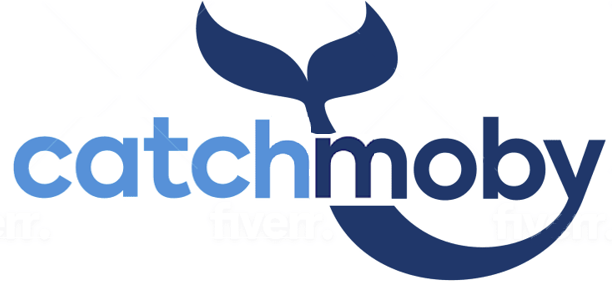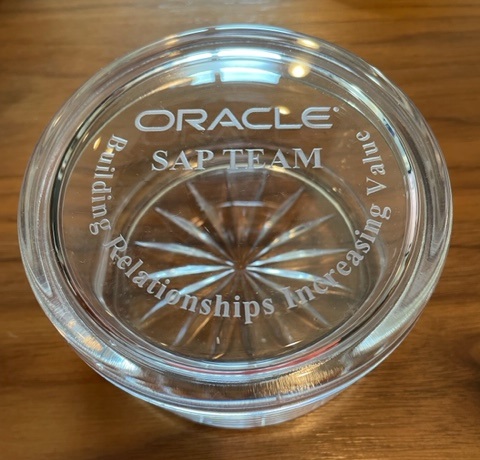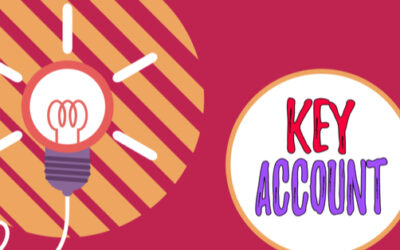After 30 years you can imagine how much junk (I mean awards, mementos, etc.) you can gather from the companies you work for. Especially during the 90’s and early 2000’s which were they heyday of the technology conference and especially of the swag. But when there is a significant meaning behind a certain piece, I keep it on my desk as a reminder. One such piece is the candy dish pictured above. No, I am not in need of a candy dish per say, but there is a story that goes along with the dish that I will always remember.
In the mid 2000’s before all of this cloud stuff, there were two major giants in technology when ERP was all the rage – SAP and Oracle. I had just left SAP (namely because of the influx of people from Siebel – but that’s a story for another day). As soon as I was hired, I was whisked off to Texas to be part of a super-secret mission – the Oracle SAP team. Yes, I wish it had a better name like operation stingray, but that was Oracle’s style – direct and to the point.
The Secret Oracle SAP Team
This team was a group of employees cobbled from each of Oracle’s regions that had experience working at SAP. The mission was clear – how can we beat SAP and take away their market share. I remember this exercise very clearly because after working at Oracle for a while I realized that Oracle was literally the opposite of SAP in every way imaginable. Oracle was obviously US based with a brash yet enigmatic figurehead in Larry Ellison. SAP America was actually a franchise of SAP AG headquartered back in Germany. Oracle’s genesis was the relational database while SAP was started by ex-IBM engineers for the purpose of “Systems, Applications, and Products in Data Processing”. At Oracle we would literally ask ourselves WWLD or “What would Larry do?”. At SAP we would literally say, “Let’s hope the Germans don’t find out!”
Different Go to Market Approaches
But most importantly there was a bigger distinction which fascinated me since I was a member of both of their sales departments – it was their go to market strategy. To start with, Oracle really had a bottom-up approach. They had the industry leading relational database which they tried to position everywhere they could and even into the late 2000’s the database was still the darling of the company. Once the database was positioned, they would say “Hey customer, you know what runs really well on Oracle database? Oracle ERP!!” SAP was positioned very differently since they ran on multiple databases. They focused on the higher-level executives and their business issues that could be solved by their ERP applications.
While Oracle was doing demos and going over features and functions and performance statistics, SAP was asking customers how they could help them grow their revenues or increase market share. On one occasion while at Oracle, I had the benefit of using my experience at both companies to create a sales cycle that combined the best of both worlds to close an automotive advertising company (you may know their famous book which is colored blue).
Adapt in Order to Grow
To Oracle’s credit, one of the major differences (given the American ingenuity on which they were founded) between them and SAP is that they were willing to adapt and try anything that was successful. To that end they pivoted to focus more on customer relationships and business drivers which led them to grab significant market share from SAP in the 2000’s. However, soon came the onset of the cloud and SaaS applications which caused a revolution in the applications market that left SAP and Oracle playing catch up.
So, what can we learn today from these two behemoths battling each other during the ERP heydays? I think the main lesson is that you need to evolve – not only your product but your go to market strategy. Yes, both SAP and Oracle retooled their products and made several acquisitions – they are both equally competent in database, middleware, cloud, SaaS, etc. But more importantly they constantly reviewed their go to market strategy with respect to sales and marketing.
A Sales and Marketing Revolution
We are currently in another revolution for B2B technology companies looking to market and sell to their customers. Industry experts like McKinsey tell us that these companies need a significant part of their revenue from large, strategic customers. Others, like Gartner, note that in order to land these larger customers, your sales and marketing efforts need to be more personal and engaging to cut through all the noise (mostly created through automation and bots).
The Future of Marketing
With that in mind, the future of marketing when it comes to landing strategic customers is Account Based Marketing. ABM is a completely different from typical lead or demand generation marketing. ABM doesn’t rely on a generic persona or try to identify triggers or intent from the general public. Instead, ABM identifies upfront who the best targets are, and then unleashes a hyper-personalized and engaging campaign in order to create a meaningful engagement with each of those targets individually.
Imagine for a minute that you want to capture F500 clients from financial services and you have your sights set on a handful of prospects including Acme Investment Company. Instead of creating expensive marketing campaigns hoping they click on a link or attend a webinar, you could research the account and create a targeted landing page specifically for Acme with all the relevant information of why they should by your product or service. Then you follow up with a targeted marketing campaigns specifically for Charlie the CFO, Jennifer the CEO, Lamar the CIO, etc. This is the future of marketing – personalized and engaging marketing that differentiates you from the competition and provides immediate value to your prospects.
Much like SAP and Oracle have experienced over the past several decades, technology as well as sales and marketing have evolved. Sometimes that evolution has been for the worse (AI chatbots) and sometimes for the better – ABM! Reach out to CatchMoby today to discuss your sales strategy and how we can help you reach the highest ROI for your sales or marketing dollar – or if you just want to hear some more SAP or Oracle stories!






0 Comments